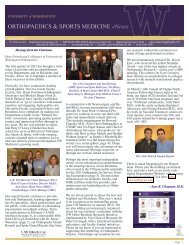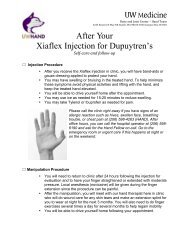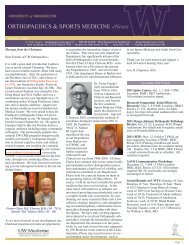2002 - University of Washington Bone and Joint Sources
2002 - University of Washington Bone and Joint Sources
2002 - University of Washington Bone and Joint Sources
Create successful ePaper yourself
Turn your PDF publications into a flip-book with our unique Google optimized e-Paper software.
(A)<br />
(B)<br />
Figure 2: GFP expression was monitored under laser light (488 nm) in induced cells (A) <strong>and</strong> uninduced<br />
cells (B). Only those cells that were induced show significant expression <strong>of</strong> GFP.<br />
implications as a general mechanism<br />
for the initiation <strong>of</strong> tumor<br />
development.<br />
Our results showed that the EWS/<br />
Fli-1 fusion protein was successfully<br />
down-regulated by the expression <strong>of</strong><br />
antisense EWS/Fli-1 RNA in Ewing’s<br />
cells. This inducible system permits us<br />
to study genetically identical cells that<br />
differ only in the presence or absence<br />
<strong>of</strong> the EWS/FLI-1 fusion protein. As<br />
appropriate control constructs are also<br />
used, any changes in splicing patterns<br />
in these cells should therefore be<br />
attributable to the effect <strong>of</strong> the fusion<br />
protein itself.<br />
Alternatively spliced forms <strong>of</strong><br />
CD44 <strong>and</strong> Bin-1, proteins important in<br />
cell growth <strong>and</strong> differentiation, were<br />
identified by comparison <strong>of</strong> splicing<br />
patterns before <strong>and</strong> after the EWS/Fli-<br />
1 fusion protein was down-regulated.<br />
CD44 splice variants have been<br />
associated with increased invasiveness<br />
<strong>and</strong> loss <strong>of</strong> contact inhibition in tumor<br />
cells. Alternatively spliced forms <strong>of</strong> Bin-<br />
1 no longer possess the ability to<br />
interact with the protein myc, resulting<br />
in the inability <strong>of</strong> myc to function as a<br />
tumor suppressor. Our findings<br />
indicate that aberrant splicing <strong>of</strong> premRNA,<br />
as mediated by the EWS/Fli-1<br />
fusion protein, may explain the myriad<br />
changes in gene expression that<br />
transform a benign mesenchymal cell<br />
into a malignant sarcoma.<br />
RECOMMENDED READING<br />
Figure 3: The proliferation rates <strong>of</strong> induced <strong>and</strong> uninduced cells were measured over 72 hours. Equal<br />
numbers <strong>of</strong> cells were initially seeded <strong>and</strong> counted at each time point using tryphan blue staining to<br />
identify viable cells. Uninduced cells exhibited a greater rate <strong>of</strong> proliferation than the induced cells<br />
since the fusion protein confers a growth advantage in Ewing’s cells.<br />
known about its functional effects on<br />
cells. This study explored the possibility<br />
that the fusion protein could promote<br />
tumorigenesis by interfering with<br />
mRNA splicing in Ewing’s cells.<br />
Aberrant splicing <strong>of</strong> pre-mRNA is a<br />
poorly understood but common<br />
feature <strong>of</strong> human tumors. Because<br />
alternative splicing can lead to the<br />
expression <strong>of</strong> nonfunctional proteins or<br />
proteins with altered activity, this<br />
process might have important<br />
Rapp, T.B., Yang, L., Conrad, E.U.,<br />
M<strong>and</strong>ahl, N., Chansky, H.A. J. Orthop.<br />
Res., Submitted November, 2001.<br />
Chansky, H.A., Hu, M., Hickstein, D.D.,<br />
Yang, L. (2001) Cancer Res. 61 3586-<br />
3590.<br />
Yang, L., Chansky, H.A., <strong>and</strong><br />
Hickstein,D.D. (2000) J. Biol. Chem.<br />
273, 37612-37618.<br />
Ge, K., DuHadaway, J., Du, W., et al.<br />
(1999) Proc. Natl. Acad. Sci.USA 96,<br />
9689-9694.<br />
Sneath, R.J.S., Manghan, D.C. (1998)<br />
J. Clin. Pathol.: Mol. Pathol. 51 191-200.<br />
Delattre, O., Zucman, J., Plougastel, B.<br />
et al. (1992) Nature 359, 162-165.<br />
<strong>2002</strong> ORTHOPAEDIC RESEARCH REPORT 31















